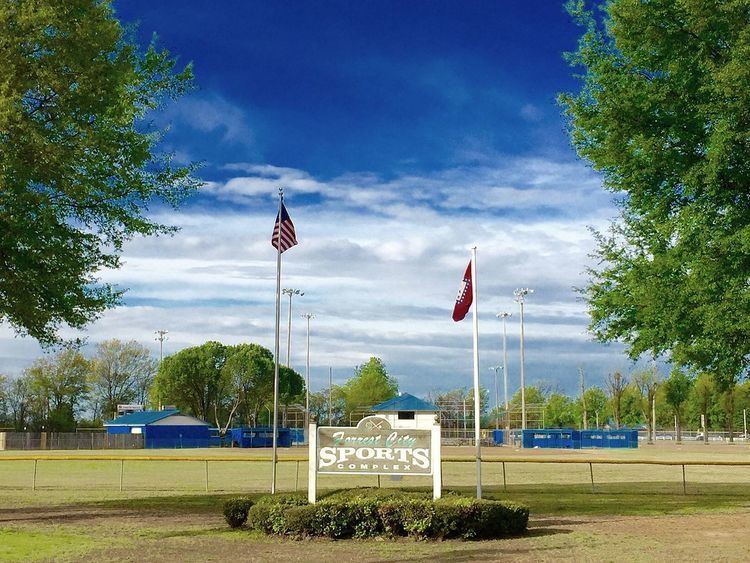Country United States County St. Francis FIPS code 05-24430 Elevation 77 m Local time Tuesday 6:38 PM | Time zone Central (CST) (UTC-6) GNIS feature ID 0083152 Population 15,016 (2013) Number of airports 1 | |
 | ||
Weather 2°C, Wind N at 14 km/h, 72% Humidity Area 42.48 km² (42.22 km² Land / 26 ha Water) Colleges and Universities East Arkansas Community College, Crowleys Ridge Technical Institute | ||
Forrest City is a city in St. Francis County, Arkansas, United States, and the county seat. It was named for General Nathan Bedford Forrest, who used the location as a campsite for a construction crew completing a railroad between Memphis and Little Rock, shortly after the Civil War. The population was 15,371 at the 2010 census, an increase from 14,774 in 2000. The city refers to itself as the "Jewel of the Delta".
Contents
- Map of Forrest City AR 72335 USA
- History
- Geography
- Demographics
- Government and infrastructure
- Local landmarks
- Notable people
- References
Map of Forrest City, AR 72335, USA
History
On October 13, 1827, St. Francis County, located in the east central part of Arkansas, was officially organized by the Arkansas Territorial Legislature in Little Rock. Confederate general Nathan Bedford Forrest became interested in the area around Crowley's Ridge during the Civil War. In 1866 General Forrest and C. C. McCreanor contracted to finish the Memphis & Little Rock Railroad from Madison located on the St. Francis River to DeValls Bluff on the west bank of the White River. The route traversed the challenging Crowley's Ridge and L'Anguille River bottoms. The first trains came through in 1868.
General Forrest later built a commissary on Front Street. Colonel V.B. Izard began the task of designing the town at the same time. Most residents were calling the area "Forrest's Town," later to be known as Forrest City, incorporated May 11, 1870. The county seat was initially located in the now defunct town of Franklin until 1840 when it was moved to Madison. In 1855 it was moved to Mount Vernon where the court house burned in 1856 destroying county records prompting a move back to Madison. The county seat was moved to a wooden structure in Forrest City in 1874, which burned shortly thereafter, again destroying county records.
In 1940, Forrest City was a stop for the Choctaw Rocket, a passenger train operated by the Chicago, Rock Island and Pacific Railroad. Service was discontinued in 1964.
Evidence that giant mastodons roamed the slope was revealed in 1949 when workmen excavating for sewer improvements found bones of the massive beasts within the city limits.
Forrest City High School held its first integrated prom in 1988. After school integration was ordered in the mid-1960s, Forrest City eliminated school-sponsored dances and social activities. For 23 years, social clubs and individual families had organized a racially segregated prom.
Geography
Forrest City is located at 35°0′36″N 90°47′19″W (35.010131, -90.788716). Technically Forrest City is in northeast Arkansas using standard navigational methods.. According to the United States Census Bureau, the city has a total area of 16.3 square miles (42 km2), of which 16.2 square miles (42 km2) is land and 0.1 square miles (0.26 km2) (0.37%) is water.
Forrest City is located on Crowley's Ridge, a geological phenomenon that rises above the flat Mississippi Delta terrain that surrounds it. This north-south running highland is some three miles wide and 300 feet above sea level. Several species of trees not indigenous to Arkansas are found here, including beech, butternut, sugar maple, and cucumber trees.
Demographics
As of the census of 2000, there were 14,774 people, 4,581 households, and 3,165 families residing in the city. The population density was 908.7 people per square mile (350.8/km²). There were 5,164 housing units at an average density of 317.6 per square mile (122.6/km²). The racial makeup of the city was 35.52% White, 60.93% Black or African American, 0.19% Native American, 0.74% Asian, 0.30% from other races, and 2.31% from two or more races. 8.26% of the population were Hispanic or Latino of any race.
There were 4,581 households out of which 37.5% had children under the age of 18 living with them, 37.2% were married couples living together, 28.0% had a female householder with no husband present, and 30.9% were non-families. 27.9% of all households were made up of individuals and 11.9% had someone living alone who was 65 years of age or older. The average household size was 2.65 and the average family size was 3.23.
In the city, the population was spread out with 27.5% under the age of 18, 10.5% from 18 to 24, 32.3% from 25 to 44, 18.5% from 45 to 64, and 11.1% who were 65 years of age or older. The median age was 32 years. For every 100 females there were 116.1 males. For every 100 females age 18 and over, there were 121.6 males.
The median income for a household in the city was $23,111, and the median income for a family was $27,432. Males had a median income of $29,313 versus $21,295 for females. The per capita income for the city was $11,716. About 29.0% of families and 33.4% of the population were below the poverty line, including 45.9% of those under age 18 and 22.3% of those age 65 or over.
Government and infrastructure
The Federal Bureau of Prisons Federal Correctional Complex, Forrest City is in Forrest City.
The United States Postal Service operates the Forrest City Post Office.
Woodruff Electric Cooperative, a non-profit rural electric utility cooperative, is headquartered in Forrest City.
Local landmarks
The Forrest City Chamber of Commerce is located in the 100-year-old Becker House. This house has served a variety of functions since being sold by the Becker family. It was an antique store and later a home furnishings boutique before being occupied by the Chamber.
Forrest City had five sites listed on the National Register of Historic Places including:
